AZZA Silentium Case Review: Knowing the Limits
by Dustin Sklavos on January 29, 2013 12:01 AM EST- Posted in
- Cases/Cooling/PSUs
- quiet
- AZZA
Noise and Thermal Testing, Stock
Given the way AZZA designed the Silentium, its performance under stock settings is really going to be what we're interested in. This is not an enthusiast-class case, and the bog standard ATX cooling system is clearly not intended to handle high-performance builds. Unlike many other cases designed for silent running, AZZA barely even makes allowances for performance.
What we're really going to want to see is just how the stock fans perform. There's no fan controller included and both fans use a standard molex connector. They're also both 120mm fans when the industry is beginning to graduate to 140mm, so they may not be able to move much air.
I've added another unfortunate wrinkle into the mix, though: I've added the test results from the Nanoxia Deep Silence 1 and the Fractal Design Define R4. The R4 is about $10 more than the Silentium and a much more flexible enclosure, while the DS1 is expected to arrive on US shores at around $119. If it does, and that's a big "if," it's going to seriously jeopardize the value propositions of a lot of the cases here, including the Silentium.
Ambient temperature during testing was ~22C.
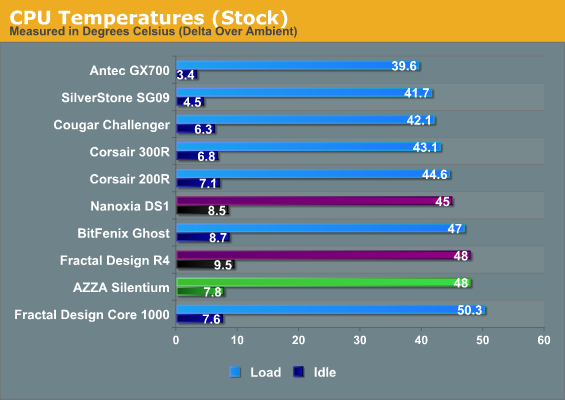
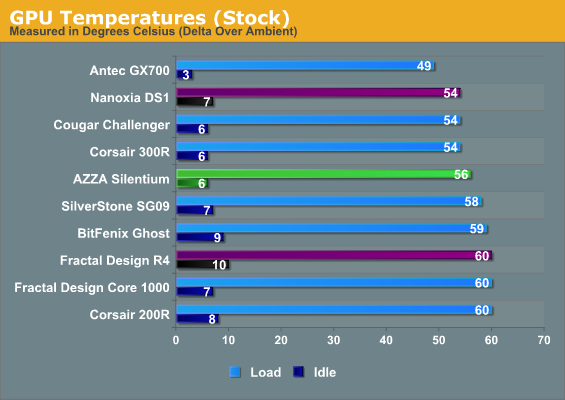
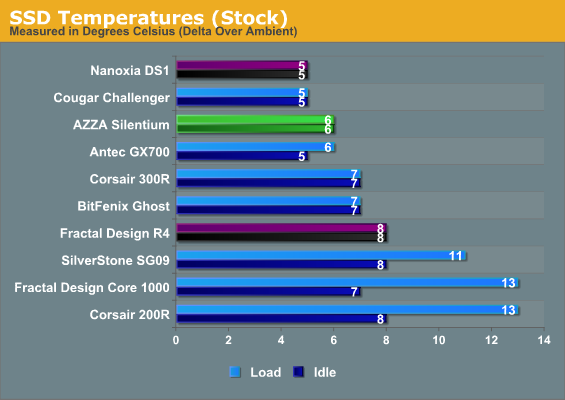
Thermals at stock aren't particularly impressive, and the Silentium is really competing with the BitFenix Ghost at its price point. The Define R4 was never a stellar performer, but it's flexible if you're willing to play with it. It's also much better built than the Silentium.
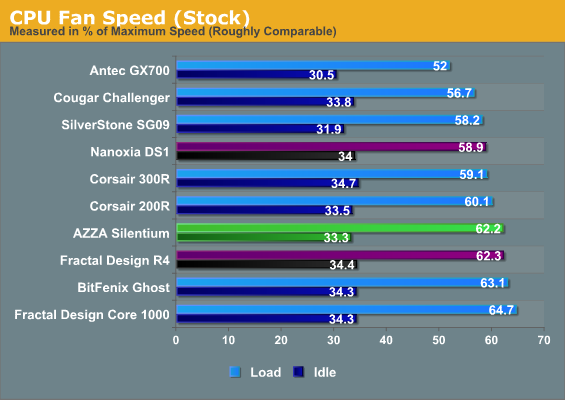
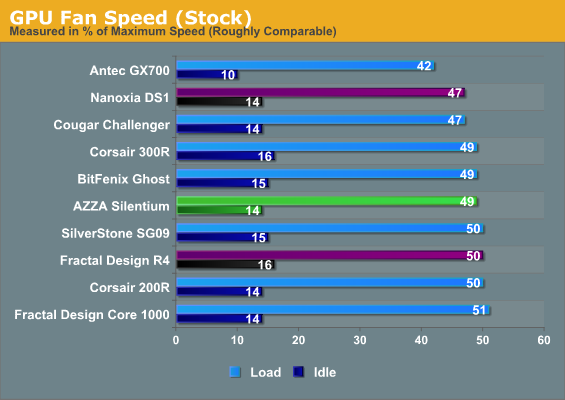
CPU and GPU fan speeds prove the Silentium, Ghost, and R4 are pretty much neck and neck with each other while Nanoxia's enclosure provides better value across the board.
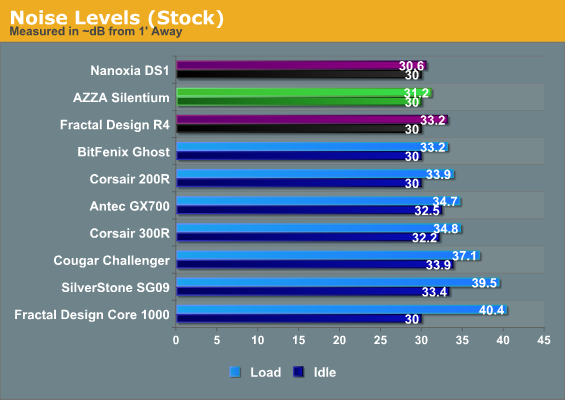
AZZA is able to put a little bit of distance between itself and the competition in our acoustic testing, though. They use thicker dampening material and more of it than the competing cases do, and it shows. That said, the DS1 is still quieter while offering better thermals and airflow.










22 Comments
View All Comments
Stuka87 - Tuesday, January 29, 2013 - link
But do you plug those drives into the front of your case? I plug my drives into the rear, and if I have a temp drive to transfer data to/from, then that one drive will plug into the front.cjs150 - Tuesday, January 29, 2013 - link
Need better thought than this.Because I have no need for a full ATX board, Silverstone could do a fantastic silent case.
Take the TJ08, widen it slightly to allow room for dampening material (and cable management), maybe a revamp to the front so that (so similar to Antec 180), look at PSU mounting (lots of silicon dampening) and my personal bug bear - will someone please include some anti vibration mountings for optical drives!
Grok42 - Wednesday, January 30, 2013 - link
First, simply don't install an optical drive and it will add 0dB of noise to your system. If you can't handle not having "lasers" inside your computer then realize that spinning a 16g polymer plastic disc at 10k+ RPM is going to make enough noise that any vibration transmitted to the case will be incidental.ShieTar - Tuesday, January 29, 2013 - link
How is the Ghost doing the "best job", if the DS1 outperforms it in almost every single measurement?
And how does the R4 start to look like a better deal, if it is noisier than the AZZA with higher GPU temperatures, while being more expensive?
It seems like those conclusions were written without looking at the measurement results at all.
Hrel - Tuesday, January 29, 2013 - link
Man I want that to case to come over here.UNhooked - Tuesday, January 29, 2013 - link
Given how we have so many All in one watercooling solution it would be nice if you started to incorporate a small section for watercooling with the mainstream coolers. Corsair H100, H80 etc.Ananke - Tuesday, January 29, 2013 - link
I look at the picture, I read till " it's cheaper to use a single USB 3.0 port and a single USB 2.0 port by a couple of bucks" and decided that this is a $19-29 market case at best. At $99 it is a joke. My Dell workdesk PC is dead silent regardless its canny thick case. There is no reason this AZZA plastic POS to be $99 expensive.Beaver M. - Tuesday, January 29, 2013 - link
Seriously, dont do it. Buy a case which is not like Swiss cheese and do it yourself accurately.Even cheap cases will turn into sound eating monsters (especially weight-wise).
Plus they will be completely air tight, so the air flow of the case fans will be excellent without any increase in temperature.
Sure, getting off the side panel and back on, will be more work, but it will really eat sound like nothing and will be more than worth the 12 hours spent to get it done. I can actually run my fans on much higher speeds before I hear them and I never have issues with other noise. You wont believe how quiet my DVD drive is.
Pre-insulated cases are placebos.
althaz - Tuesday, January 29, 2013 - link
Whilst an air-tight case would definitely be quieter, it's not an option for most people as they don't wish to replace their entire computer every day after it is damaged from excessive heat.If there's not fresh air coming in, your computer will gradually get hotter and hotter until something in it melts.
A closed design case will be quieter than an open design, but even closed designs need to allow for sufficient air to flow out of and especially into the case.
Tech-Curious - Tuesday, January 29, 2013 - link
I think he meant air-tight except for the fan vents. ;)"Plus they will be completely air tight, so the air flow of the case fans will be excellent without any increase in temperature."